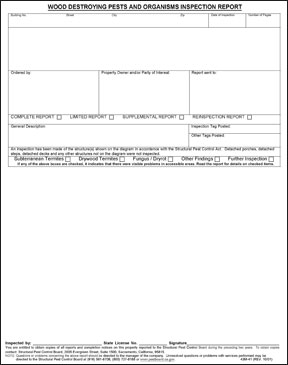


Reading Your Termite Inspection Report
 |
| The standard termite report format. |
Your report, no matter which company issues it, is in a standard format which is dictated by the Structural Pest Control Board. There is a huge amount of explanatory information in the fine print of your report, but for your convenience, we have summarized some of the more common questions, in plain language (we hope).
On the front, you will find the inspection company's name and information, the inspected property's address and a short description of it, the party ordering the inspection, and so on. You will see a rough diagram of the property inspected, with or without codes—indicating findings—noted on it.
What is a Complete Report, a Limited Report, a Supplemental Report, and a Reinspection Report?
About a third of the way down the report, you'll see a set of four checkboxes indicating the following choices: Complete Report, Limited Report, Supplemental Report, and Reinspection Report.
The first report you'll usually see on a property is a Complete Report or a Limited Report, as these are the two types of original reports.
- A Complete Report will detail the inspector's visual findings throughout the property, excluding any inaccessible areas, which will be noted in the Findings section.
- A Limited Report is often made on condominiums or other properties whose outside areas are maintained by another entity—a homeowner's association, for example, or in multi-unit properties where only one unit is inspected. But a Limited Report can be requested at any time, if an owner or property manager wants only a section of their property inspected. For example, a homeowner knows there are termites in the garage and would like to know the extent of the damage.
Supplemental Reports and Reinspection Reports are non-original reports; they each refer to an original (Complete or Limited) report.
- A Supplemental Report is made when areas deemed inaccessible in an original report are made accessible, and as such, need to be inspected. A Supplemental Report can also be used to correct, add, or modify information in a previous report.
- A Reinspection Report details the inspection of items completed (fixed or repaired), as recommended on an original or subsequent report. An inspection company will inspect repairs done by others* within four months of the original inspection. (*A Reinspection Report is not required if the termite inspection company that issued the original report is hired to do the repairs. This is simply because when they perform the repairs themselves, they know those repairs are done to the recommendations on their own, original report.)
What if a box is checked for Subterranean Termites, Drywood Termites, Fungus/Dryrot, Other Findings and/or Further Inspection?
The next part of interest is the section of checkboxes labeled: Subterranean Termites, Drywood Termites, Fungus/Dryrot, Other Findings and Further Inspection. In a paragraph after the boxes, you are instructed to read the full report for details on any of these major findings. These are the main items most people want to know about when they order or read a pest inspection.
- Subterranean Termites: The inspector has found evidence of subterranean termites. For a description of these insects, see Wood Destroying Organisms on the Termites and Other Wood Destroying Organisms page. This could mean live subterranean termites, evidence of old, now absent subterranean termites, damage from subterranean termites, or any combination of these things.
- Drywood Termites: The inspector has found evidence of drywood termites. For a description of these insects, see the Termites and Other Wood Destroying Organisms page. This could mean live drywood termites, evidence of old, now absent drywood termites, damage from drywood termites, or any combination of these things.
- Fungus/Dryrot: Many people are confused by this finding. "Dryrot" is actually a layperson's term for fungus damage, so fungus itself, as well as the damage caused by fungus, a.k.a. "dryrot", are both included in this finding. Each termite company will typically use only one of the terms "dryrot" or "fungus damage" within their report findings, but they mean the same thing. Any of several types of wood-decaying fungi can be found in your structure. They feed on the wood and can significantly compromise its structural integrity.
- Other Findings: This section will be checked when there are findings other than the above items found in your structure. Some things that would fall into this category can directly affect the integrity of the wood, including wood-destroying beetles, carpenter ants, carpenter bees, and dampwood termites. Other findings under this heading are items considered to be conducive conditions, or "conditions deemed likely to lead to infestation or infection," such as all Section II items. For a description of Section I & Section II, please see the Termites and Other Wood Destroying Organisms page.
- Further Inspection: This box will be checked if the inspector was unable to access an area or areas within the structure for inspection, or when the inspector has noted an infestation or infection, but recommends opening a portion of the structure for a more thorough inspection of the extent of the infestation or infection.
It is important to note that the above checkboxes are provided on each report as a sort of at-a-glance synopsis, but reading the individual findings in the report is necessary to get all the information you need about the items found during your property's inspection.
The information on this site is provided for our customers' convenience only, and is not intended to be a complete reference of state laws and regulations concerning wood destroying organisms, nor a complete reference of the wood destroying organisms themselves. For more information, please contact the California Structural Pest Control Board and/or an entomologist.
Flexible Scheduling · Fast, Friendly Service
Order your termite, home and roof inspections together for a package discount.
Call for details.
Call The Bugsmith at 510-409-6809